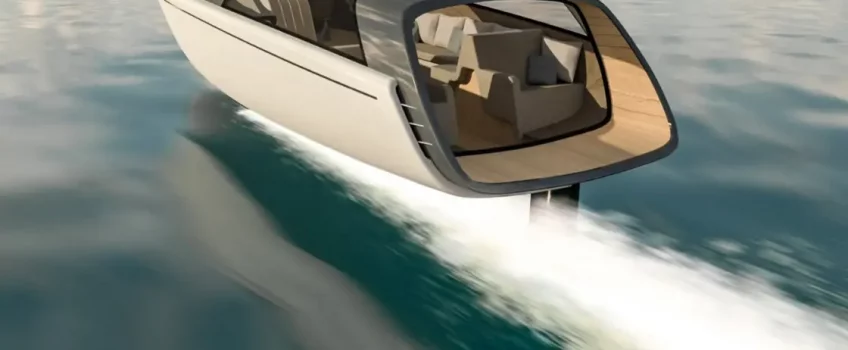
Whether it’s wind power, hydrogen or electric vessels, decarbonising efforts in the maritime sector are reaching new heights. Among the latest developments is the new Alte Volare electric hydrofoil concept from British superyacht tender specialists, Cockwells. Here’s what we know.
New Electric Vessels: Alta Volare Electric Hydrofoil
From the pictures, it’s evident that the Alta Volare is one of the sleekest electric vessels of its kind so far. Referred to as a limousine tender, it relies on a combination of an electric powertrain, retractable hydrofoils and a modern, smooth hull for faster, more efficient shuttling. It’s designed to transport 10 passengers from shore to a bigger boat while enjoying a clean, quiet, comfortable ride with protection from the elements.
The Alte Volare was introduced as a technical study at the Monaco Yacht Show earlier this month and it certainly delivered. Designed with Cockwells’ ethos of “pushing the boundaries of the possible when it comes to fusing advanced engineering with intelligent design”, the end result proves that they’ve done just that. The Alta Volare might look like something from a Bond movie but it’s as practical and efficient as it is stylish.
Efficiency In Design
The Alte Volare has a sharp bow and sleek hull lines that look primed to slice through the water like a hot knife through butter but it doesn’t have to. Instead, the retractable foil system will lift the body over the water’s surface to provide a faster, smoother and more energy-efficient ride. Under the proverbial bonnet is an e-drive single electric motor integrated into the front foil while the rear incorporates the control surfaces.
The Alta Volare can reach speeds of up to 40 knots (74 km/h) while gliding over the waves a lot easier than similar combustion engines or electric vessels. According to Cockwells, this system can help reduce energy usage by a staggering 80%. Perhaps this could revolutionise electric vessels of the future!
Electric Vessels With A View
Along with 10 passengers, the 38.7-foot (11.8-m) Alta Volare can accommodate two crew members with access through fold-out midship steps. There are port and starboard sofas for up to eight people with two individual recliners facing out the full-height window for a mesmerising experience.

The cockpit’s wraparound design makes it distinct from the rest of the deck while the low, sleek windscreen separates the five-seat bow lounge from the cockpit. This lounge comes with a removable infill cushion to create a sun pad. Although the aft of the cockpit may seem exposed to the elements, it’s actually protected from sea and sky by a panoramic glasshouse.
Although the Alte Volare is only a technical study at the moment, Cockwells’ initial entry into hydrofoil design shows exceptional promise. The company is open to inquiries and if someone does place an order, it’s only a matter of time before we see more of these electric vessels take to the waves.
Decarbonising Maritime Transport With Electric Vessels
The maritime sector produces 940 million tonnes of CO2 per year, contributing between 2.5% and 3% of global greenhouse gas emissions. As a result, the maritime industry has been hard at work finding an alternative to fossil fuels, including electric vessels powered by lithium-ion batteries. Below are a few of the standouts.
Stena Jutlandica
Ferry operator Stena Line is planning to add a 1,000kWh battery system to its Stena Jutlandica ferry, which operates between the cities of Gothenburg, Sweden and Frederikshavn, Denmark.
AIDAperla
German cruise line AIDA Cruises received a 10,000kWh lithium-ion battery system from energy storage solutions provider Corvus Energy. It is the largest of its kind to be delivered to a ship and was installed on the company’s AIDAperla cruise ship with a capacity of more than 4,000 passengers and crew members.
Ellen
Partially funded by Horizon 2020, the Ellen pure electric ferry project completed its ten-month sea trial in 2021. The ferry, which will operate in the Danish part of the Baltic Sea is the biggest research and innovation programme funded by the EU.
Developing electric vessels such as the Alta Volare is a big step toward decarbonisation, along with the many innovations in the automotive and aviation sectors. This is good news since transportation is a major source of pollution across the world as the resulting emissions lead to a host of problems, including extreme weather events.
For more fascinating articles covering engineering, manufacturing, technology and topics such as hydrogen aircraft, drones in manufacturing and electric vessels like the Alta Volare, please follow our blog.


 Mail:
Mail: 



